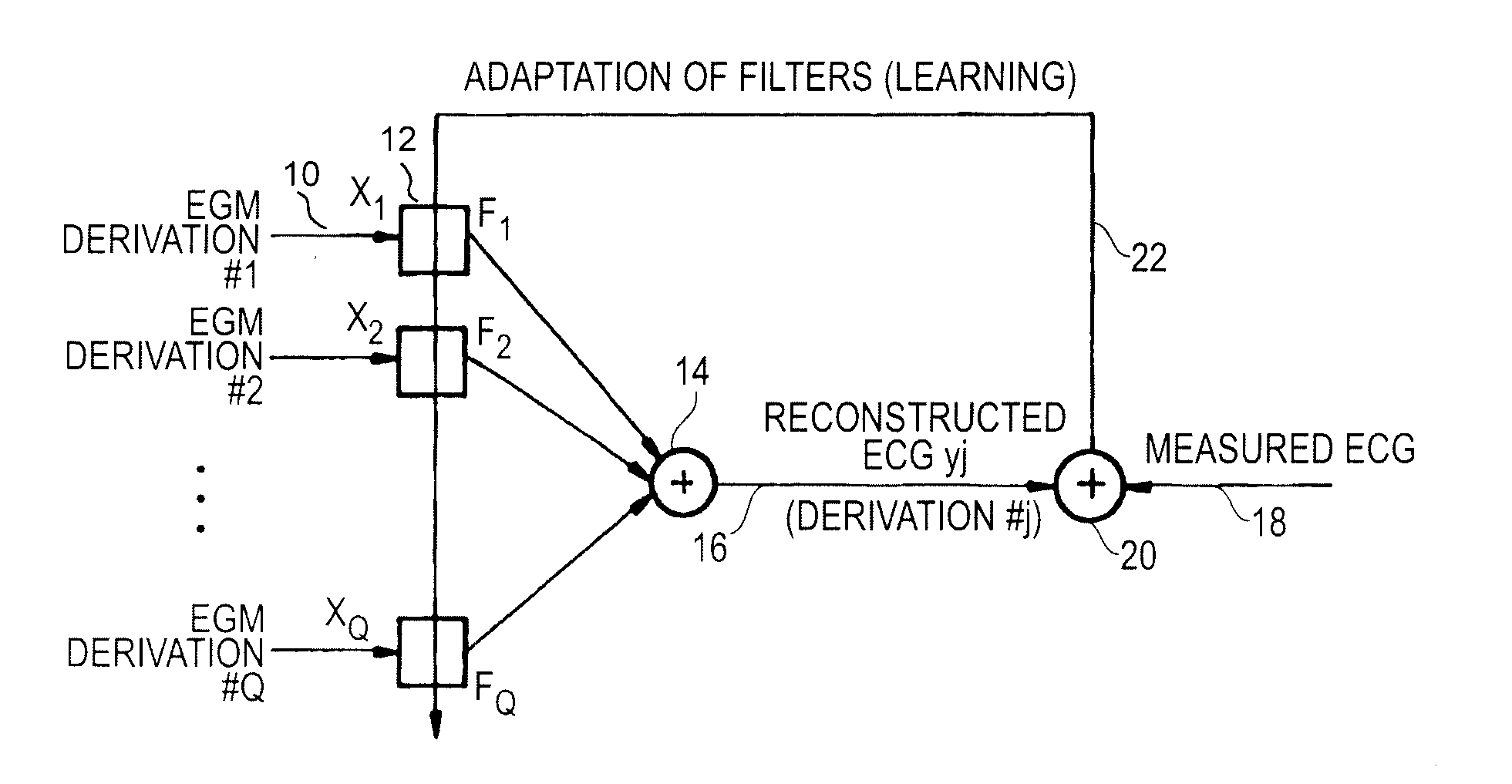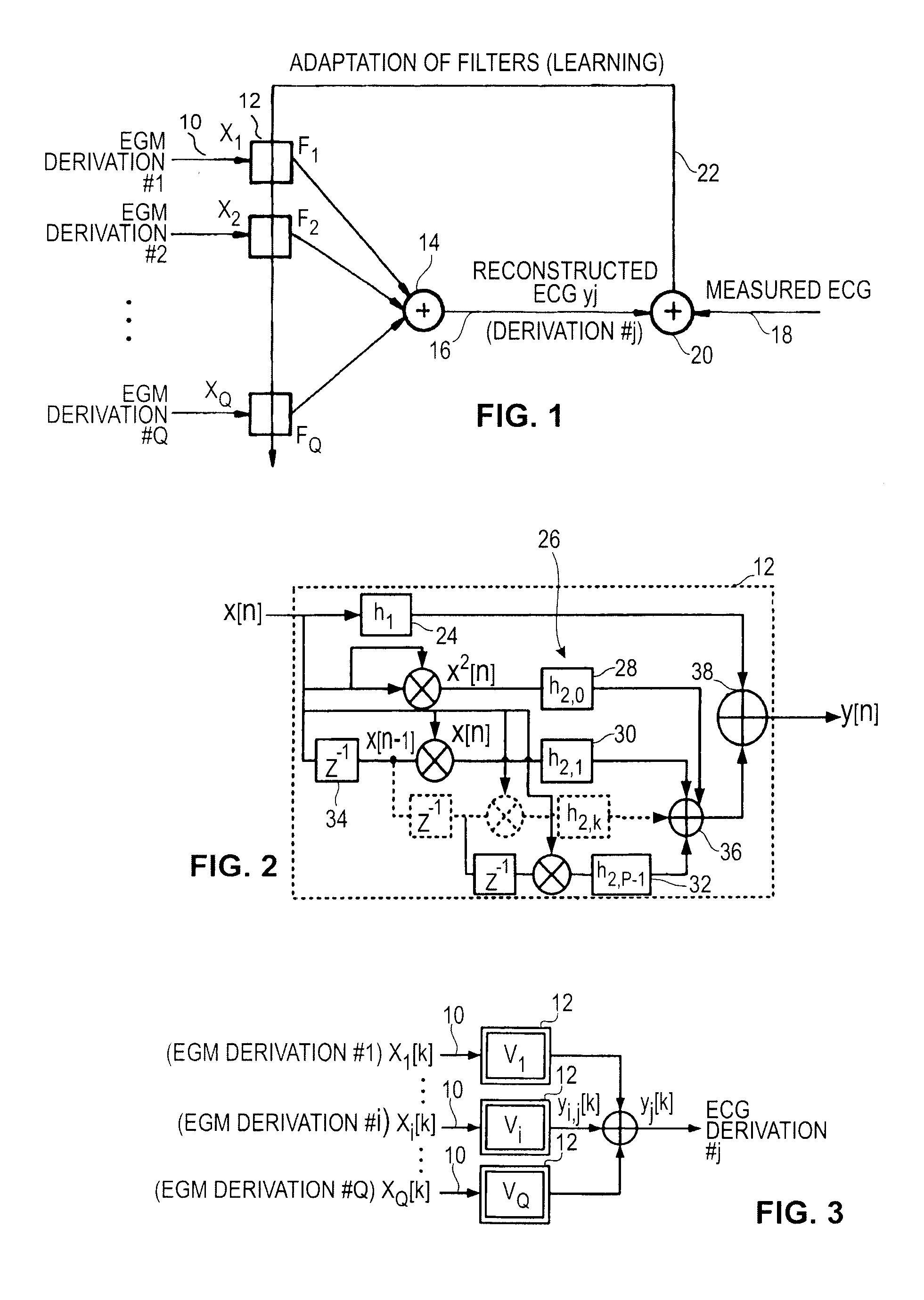Non-linear filtering for the reconstruction of a surface electrocardiogram from an endocardial electrogram
a surface electrocardiogram and endocardial electrogram technology, applied in the field of implantable medical devices, can solve the problems of less rigorous follow-up of patients, less useful display of egm signals for practitioners who interpret ecg signals, and global increase in follow-up costs. achieve the effect of improving quality
- Summary
- Abstract
- Description
- Claims
- Application Information
AI Technical Summary
Benefits of technology
Problems solved by technology
Method used
Image
Examples
second embodiment
[0096]the present invention uses a simplified version of the Volterra filter to take into account the products xi[n−k]xi[n−l] between the temporal samples of the same input signal xi[k] taken at the same sampling moments. This is equivalent to apply linear filters to their squares xi[k]xi[k]=xi2[k] . . . (diagonal terms of the kernels hm).
[0097]The contribution of the signal xi[k] of the EGM derivation n° i in the construction of the ECG derivation y[k] is then:
yi′[n]=h0i+∑k=0N-1h1i[k]xi[n-k]+∑k=0P-1h2i[k]xi2[n-k]+∑k=0M-1h3i[k]xi3[n-k]
[0098]With this simplified version, it may be advantageous to also take into account the cross-products xc[k] between several EGM inputs on the same sampling moments. In this case, the equation of the reconstructed ECG signal is:
xc[k]=x1[k]x2[k]…xQ[k]y[n]=∑i=1Qyi′[n]+∑s=0N-1hc[s]xc[n-k]
[0099]The number of unknown variables is: 1 for the constant term, QN for the linear term, QP for the quadratic term, QM for the cubic term and N for the cross product t...
third embodiment
[0107]The third embodiment implementing the present invention uses only one Volterra filter for the reconstruction of an ECG derivation, irrespective of the number Q of EGM channels. The technique, illustrated with reference to FIG. 5, is to produce a signal z[n] consisting of a concatenation of successive EGM signals xi[n]=x1[n], x2[n] . . . xQ[n]. For each sampling instant nT, the signal z is built using all the Q values of signals xi[n]. Thus, if the sampling frequency of the EGM signals is F, the frequency of the signal z[n] is equal to QF.
[0108]According to one embodiment, the function 50 is implemented by a parallel to series converter, or by a circular switch 50 switching between the Q input signals at a frequency QF.
[0109]Volterra filter 12 is applied to the signal z[n] thus formed, and produces an output signal w[n], also at the frequency QF.
[0110]The signal y[n] at frequency F, is extracted from the signal w[n] by down-sampling of order Q by keeping a value every Q values ...
first embodiment
[0117]In the case of implementation of the invention, a vector of unknowns H, of size K1 defined above, is formed by the concatenation of several sub-vectors hmi, each representing the coefficients of the kernel of order m driven by the EGM derivation signal No. i:
H=[h0,h11,h21,h31, . . . ,h1Q,h2Q,h3Q]T
[0118]This simplification of the kernels is reused for the input signal. In particular, the vector xi[n]={xi[n], . . . , xi[n−N−1]} of the EGM input No. i is associated to the vector xmi representing the non-redundant terms implied in the kernel of order m:
x1i[n]=xi[n]
x2i[n]={xi[n−k]xi[n−l]}P>k≧l≧0
x3i[n]={xi[n−k]xi[n−l]xi[n−r]}M>r≧k≧l≧0
A global vector X representing the total contribution of all Q EGM inputs:
X[n]=[1,x11[n],x21[n],x31[n], . . . ,x1Q[n],x2Q[n],x3Q[n]]T
The constant 1 represents the input signal to the constant term h0 of the filter.
[0119]The input-output relationship described above for the first embodiment of implementation takes a simplified form:
y[n]=X[n]TH
[0120]...
PUM
 Login to View More
Login to View More Abstract
Description
Claims
Application Information
 Login to View More
Login to View More - R&D
- Intellectual Property
- Life Sciences
- Materials
- Tech Scout
- Unparalleled Data Quality
- Higher Quality Content
- 60% Fewer Hallucinations
Browse by: Latest US Patents, China's latest patents, Technical Efficacy Thesaurus, Application Domain, Technology Topic, Popular Technical Reports.
© 2025 PatSnap. All rights reserved.Legal|Privacy policy|Modern Slavery Act Transparency Statement|Sitemap|About US| Contact US: help@patsnap.com



